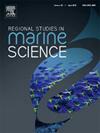Comparison of fishing performance of biodegradable and nylon gillnets with different twine diameter
IF 2.1
4区 环境科学与生态学
Q3 ECOLOGY
引用次数: 0
Abstract
Gillnets are usually made of nylon (PA) due to suitable material properties making them an efficient and commonly used fishing gear worldwide. However, considering that such gear is widely used and made of material that can endure long time of being exposed to marine environment, gillnets are often considered harmful if abandoned, lost or otherwise discarded. Such gear can cause marine plastic pollution and continue capturing marine animals over a long time (ghost-fishing). Efforts to develop new biodegradable materials to replace nylon in gillnets have been conducted. However, studies testing biodegradable gillnets have often shown reduced catch efficiency, challenging their acceptance in commercial fisheries. In this study, gillnets made of a new biodegradable PBSA material were assessed under commercial fishing conditions targeting cod (Gadus morhua) to compare their fishing performance with that of nylon nets. Two different monofilament netting diameters were tested. The results showed that relative catch efficiency between Ø 0.70 mm biodegradable and nylon nets was not significantly different (CRaverage = 107.0 % (CI: 86.2–132.1 %) and 80.58 % (CI: 15.23—155.76 %)). Increase in material diameter resulted in decrease of catches of cod of lengths 100–120 cm in biodegradable compared to nylon gillnets. This study showed that biodegradable gillnets can have a potential to reduce ghost fishing and plastic pollution at sea caused by this fishery and should be followed by further future long-term testing of material performance.
不同线径可生物降解刺网与尼龙刺网捕捞性能的比较
刺网通常由尼龙(PA)制成,由于合适的材料特性,使其成为世界范围内有效和常用的渔具。然而,考虑到这种渔具被广泛使用,并且其材料可以承受长时间暴露在海洋环境中,如果抛弃、丢失或以其他方式丢弃刺网,通常被认为是有害的。这样的渔具会造成海洋塑料污染,并在很长一段时间内继续捕获海洋动物(幽灵捕鱼)。开发新的生物可降解材料,以取代刺网中的尼龙,已经进行了努力。然而,测试可生物降解刺网的研究经常显示出捕捞效率降低,这挑战了它们在商业渔业中的接受程度。在本研究中,在商业捕捞条件下,对一种新型可生物降解PBSA材料制成的刺网进行了评估,以捕捞鳕鱼(Gadus morhua),并将其与尼龙网的捕捞性能进行了比较。测试了两种不同的单丝网径。结果表明:Ø 0.70 mm可生物降解网与尼龙网的相对渔获效率差异不显著(平均值= 107.0 % (CI: 86.2 ~ 132.1 %),80.58 % (CI: 15.23 ~ 155.76 %);与尼龙刺网相比,可降解刺网材料直径增加导致长度为100-120 cm的鳕鱼捕鱼量减少。这项研究表明,可生物降解刺网有可能减少幽灵捕鱼和这种渔业造成的海洋塑料污染,未来应该对材料性能进行进一步的长期测试。
本文章由计算机程序翻译,如有差异,请以英文原文为准。
求助全文
约1分钟内获得全文
求助全文
来源期刊

Regional Studies in Marine Science
Agricultural and Biological Sciences-Ecology, Evolution, Behavior and Systematics
CiteScore
3.90
自引率
4.80%
发文量
336
审稿时长
69 days
期刊介绍:
REGIONAL STUDIES IN MARINE SCIENCE will publish scientifically sound papers on regional aspects of maritime and marine resources in estuaries, coastal zones, continental shelf, the seas and oceans.
 求助内容:
求助内容: 应助结果提醒方式:
应助结果提醒方式:


